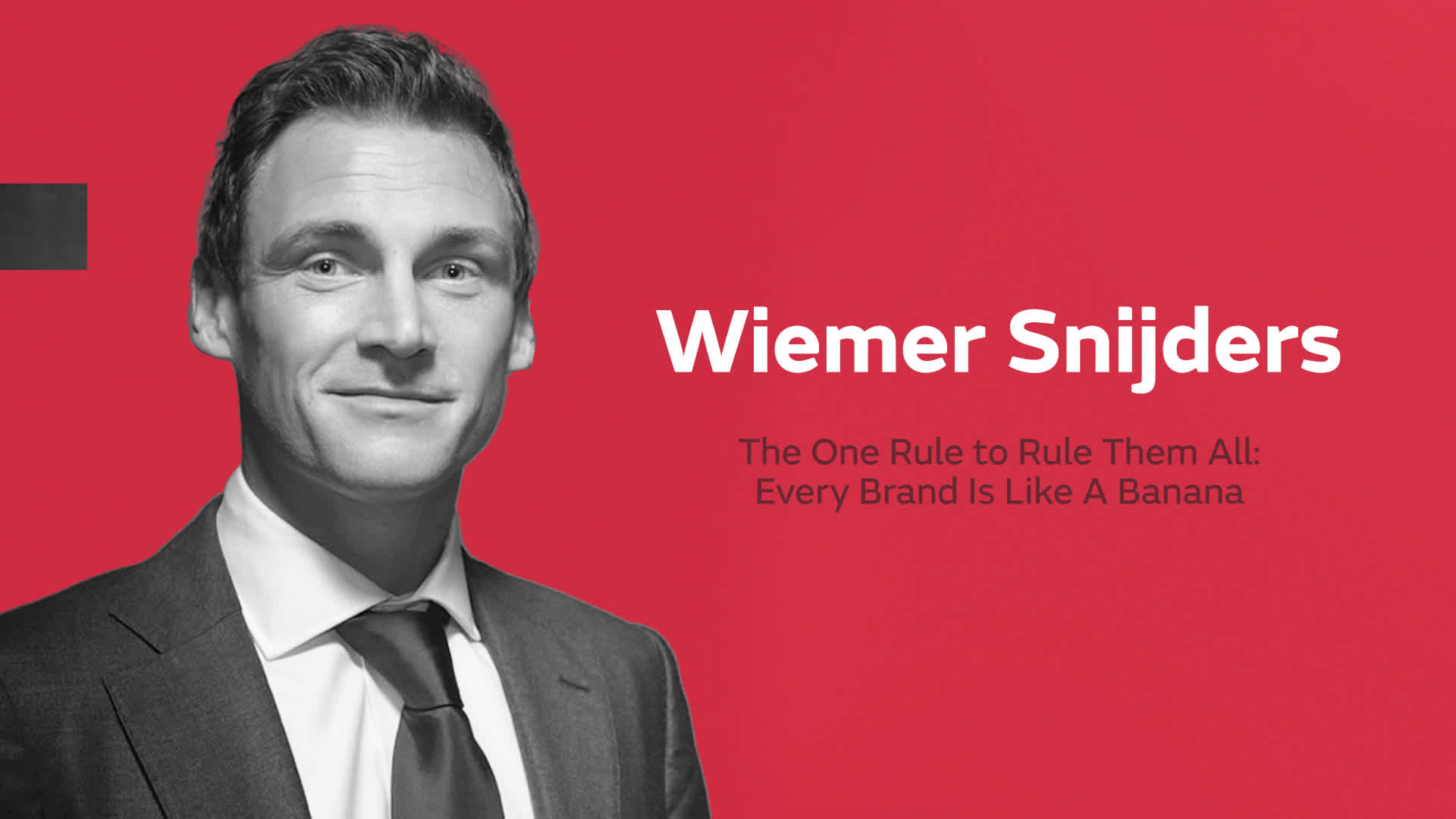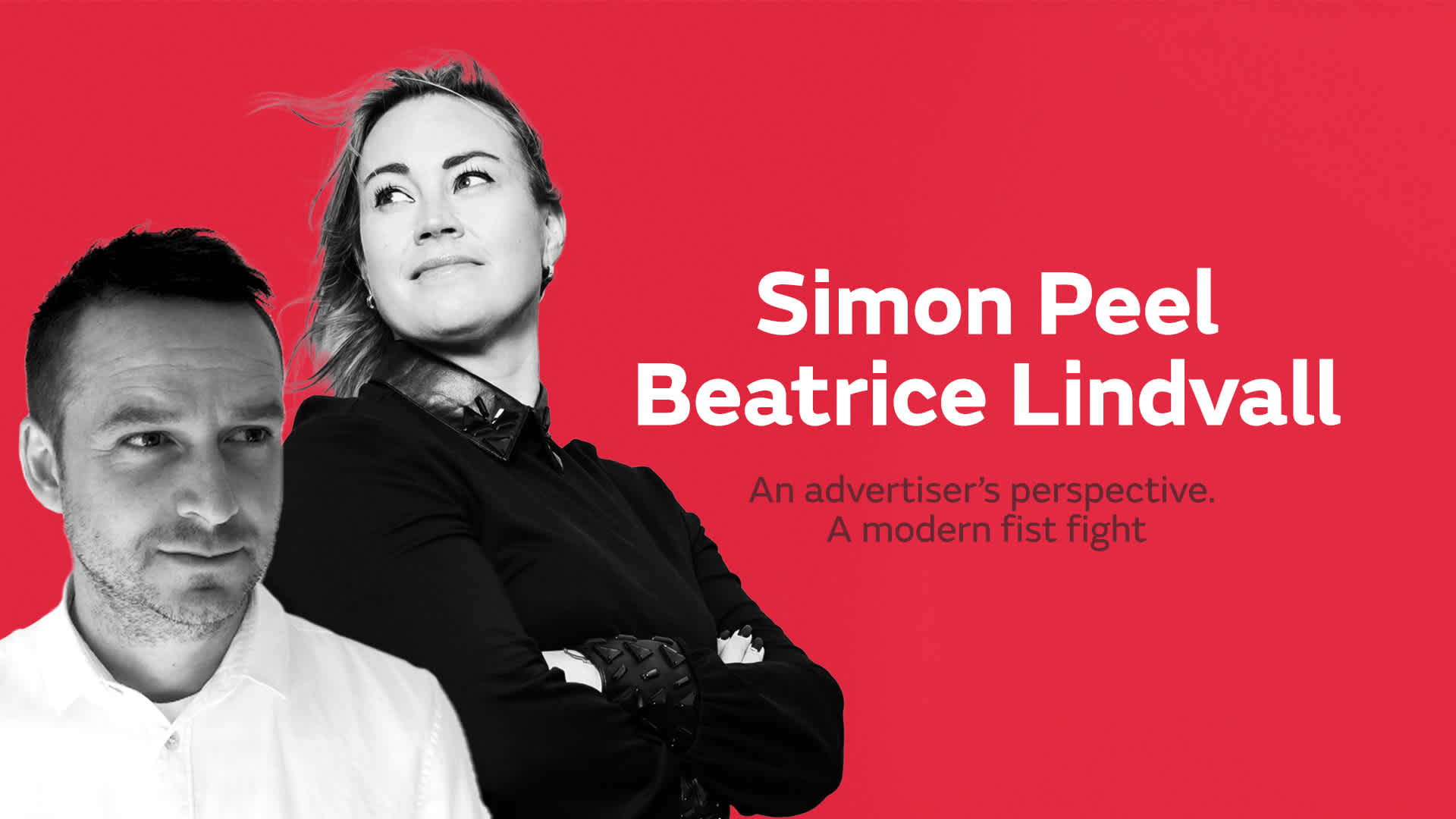”Markkinoijan tulee käynnistää ajattelumallinsa uudelleen” − MTV:n seminaarissa kuultiin, miten ottaa massit irti mediasta
MARKKINOINTI
|
( PÄIVITETTY 22.02.2022 )
09.02.2021

Kansainvälisen markkinoinnin huippunimet, Wiemer Snijders (Commercial Works) sekä markkinoinnin johto- ja kontultointitehtävissä työskentelevät Simon Peel (adidas) ja Beatrice Lindvall (Jacobs Douwe Egberts), haastoivat markkinointipäättäjiä miettimään, mistä kasvu syntyy ja millä reseptillä brändi menestyy. Lue yhteenveto 2. helmikuuta järjestetyn MTV:n virtuaalisen asiakastilaisuuden keynote-puheenvuoroista. Artikkelin lopusta löydät puhujien vastaukset yleisökysymyksiin.
Wiemer Snijders: Jokainen brändi on kuin banaani

Commercial Worksin Wiemer Snijders alusti, että tieteellisistä markkinatutkimuksista nähdään, että ihmisen ostokäyttäytyminen on jo vuosikymmenten ajan pysynyt jokseenkin muuttumattomana. Ydinhavaintona on, että vain harvat tekevät paljon, ja monet tekevät vain vähän. Asiakaskunnan ostouseutta painotettaessa jokaisen brändin asiakaskunta näyttää siis ihan banaanilta.
Usein ostavaa asiakasjoukkoa voidaan nimittää faneiksi tai brändilähettiläiksi, ja harvoin ostavia kevytostajiksi. Mittava Kantar Worldpanelin (UK data; Graham, Scriven & Bennett) 40 tuotekategoriaa ja 600 brändiä käsittävä tutkimus osoittaa kevytostajien merkityksen myyntituotoissa - 77 % asiakkaista osti tuotetta viiden vuoden aikana viisi kertaa tai vähemmän, mutta he muodostivat jopa 39 % myyntituotoista.
Kevytostajilla on suuri merkitys kasvun kannalta
Brändiuskollisiin fokusointi markkinoinnissa tuntuu houkuttelevalta ajatukselta, ja esimerkiksi digimaailman algoritmit puoltavat ajatusta kohdentaa mainontaa siihen joukkoon, josta suurimmat voitot tulevat, siis usein ostaviin. Mutta markkinoijien tulee käynnistää ajattelumallinsa uudestaan.
Nimittäin, usein ostavat ovat muutenkin jo uskollisia brändille, ja ostavat joka tapauksessa huolimatta siitä, mainostetaanko heille vai ei. Mainonnan ROI on näin ollen brändiuskollisten parissa varsin alhainen.
Asiakasuskollisuuden kasvattaminen jo olemassa olevaa asiakaskuntaa puhuttelemalla tuottaa suhteessa vähemmän hyötyä kuin banaanin ”vasempaan päähän” keskittyminen, sillä myyntituototkin noudattelevat banaanimallia. Harvalukuisuutensa vuoksi suurimpia voittoja ei voida saada useasti ostavien joukosta, painotti Snjiders.
Tavoittele laajasti koko asiakaskuntaa
Yksilötasolla liikehdintää ostouseudessa luonnollisestikin tapahtuu eri seurantajaksojen välillä; entisistä kevytostajista saattaa tulla paljon ostavia ja toisinpäin. Tästä syystä markkinointikampanjoilla kannattaa tavoitella laajasti koko asiakaskuntaa, eikä niinkään miettiä pelkästään pieniin ryhmiin kohdistettua tekemistä.
Kohderyhmiä kannattaa muutoinkin miettiä rohkeasti laajemmasta näkökulmasta. Vaikka voisi ajatella, että lastenvaatteita tai vauvojen tuotteita ostavat vain taloudet joissa on lapsia, Nielsen Scarboroughin tutkimuksesta (US data 2018) selviää, että huomattava osa näiden tuotekategorioiden ostoista tuleekin heiltä, joilla ei lapsia kotona ole. Snijders esittikin kuulijoille kysymyksen, ovatko he todella joukkio, jolle ei kannata mainostaa lainkaan?
Markkinoijan tulisikin keskittyä tähän muuttumattomuuteen: jokaisen brändin asiakaskunta näyttää banaanilta. Wiemer Snijdersin mukaan banaanista ei pääse, vaikka tarkasteltaisiin sellaisten yritysten asiakaskantaa, jotka tarjoavat tuotteiden sijaan palveluita. Samoin banaanin löytää niin B2B- kuin B2C-puolelta (Commercial Worksin asiakasdata), ja jopa maanosasta ja kulttuurista riippumatta.
Simon Peel & Beatrice Lindvall: Muista markkinoinnin kaksi roolia

Mainostajan näkökulmaa seminaariin toivat Simon Peel adidakselta sekä Beatrice Lindvall Jacobs Douwe Egbertsiltä. Heidän ydinviestinsä oli, että markkinoinnissa sekä brändirakentamiselle että myyntiaktivoinnille on paikkansa.
Markkinointi ei siis ole joko-tai, vaan sekä-että. Vaikka esimerkiksi kvartaalitalous ja paine hakea nopeita voittoja ajaa markkinointiratkaisuja helposti digitaalisiin keinoihin kustannustehokkuutensa ja mitattavuutensa vuoksi, keskittyminen vain lyhytjänteisiin tekoihin saattaa aiheuttaa ennen pitkää tilanteen, jossa lopulta ei ole brändiä, jota mainostaa. Tuotteesta tulee pelkkä hyödyke, johon ei sitouduta ja brändi jää kilpailijoiden jalkoihin, kertoi Peel. Tasapaino näiden kahden välillä vaihtelee brändistä toiseen, ja sen löytäminen on oikeastaan välttämättömyys.
Lyhyen aikavälin tekeminen maksaa pitkäaikaiset markkinointitoimenpiteet, josta taas lyhyen aikavälin tekeminen jälleen hyötyy. Brändin rakennus - tunteisiin vetoava viestintä, laaja tavoittavuus - luo brändille pääomaa, joka edesauttaa myynnin aktivointitoimia eli taktisia viestejä, joita voi kohdentaa tarkemmin.
Olennaista on kunnollisen markkinointistrategian rakentaminen, sen jalkauttaminen yrityksen eri toimintoihin ja tiimeihin sekä sen varmistaminen, että jokainen niistä on matkalla samaan suuntaan tekemisessään.
"Konteksti on kuningatar": Mieti, millaisen sisällön yhteydessä brändin halutaan näkyvän
Lindvall puhui maine-efektin merkityksestä, joka tarkoittaa, että mainonnan kontekstilla on väliä. Ennen päätöstä siitä, millä alustoilla ja missä medioissa halutaan näkyä, pitäisi miettiä sisältöä, jossa brändin halutaan näkyvän.
Onnistuneilla strategioilla ja valinnoilla päästään ihmisten mieliin ja puheenaiheeksi. Edelleenkin juuri tv on medioista se, joka luo suurimmat ilmiöt, ja siten se myös hyödyttää muita medioita moninkertaisesti (Demand Generation, 11/2019, MediaCom/Wavemaker/Gain Theory).
Markkinointi pandemian keskellä: Ole siellä, missä asiakkaatkin ovat
Kysymykseen, mikä mainonnassa on muuttunut pandemian keskellä tai mitä nyt pitäisi mainostaessa huomioida, Peel ja Lindvall korostivat sopeutumista. Pandemia ei ole muuttanut mainonnan lainalaisuuksia ja periaatteita sinänsä, joten tärkeää on olla siellä missä asiakkaatkin ovat. Kotona ollessa ollaan myös median äärellä, joten investoimalla markkinointiin nyt, voi vauhdittaa toipumista pandemian tuoman taantuman jälkeen.
… Ja lopuksi kysymyksiä!
To Wiemer: What kind of advertising strategy do you advice for retailers hit hard by Covid and urgently need to sell their stock to survive?
This will vary substantially between retailers; being able to sell online or not to name just one very obvious example. From a buyer behaviour perspective, research has shown the patterns I described do not fundamentally change during recessions and/or during the recent pandemic.
Recessions - or with this pandemic, the lack in ability to go shopping - will allow some brands to spend less on advertising as many tend to advertise less, so one can achieve similar levels of Share of Voice with relatively less spend. Some brands may even choose to go dark for a while and thus save money.
Survival means cash and to maximise the chance of sufficient cash coming in in the short term, you need to let both all the customers you ‘know’, ie have their details and as many of those you don’t that you are open and have product available now.
People’s needs change, especially in difficult times so what they bought in the past may not be a guide to their interests and needs now, so show them the full range of what you have available. And again, reach as many people as possible.
To Wiemer: Focusing on everyone takes huge amount of money. If the company has quite a limited marketing budget (small companies), there would be a high risk of losing the whole business when focusing mainly on the light buyers, right?
No. Every brand is dependent on large groups of light buyers so making sure you reach them is very important. Even brands with small budgets can invest in broad reach media - such as TV. Yet, given budgetary restraints, they will need to appreciate building up the reach will take more time. One way to be efficient with your budget is to spend it where you are ‘big’ now, and progressively build more reach and and availability (f.e. channels, product/service ranges, geographic area, etc). Patience is a virtue.
Targeting heavier buyers is often more expensive from a cost-per-contact perspective, and will hamper your ability to grow. That said, in the end the strategy should be to reach ALL category buyers (lights and heavies). The good news is that what works in reaching the light buyers, will ensure you also reach the heavies. It doesn’t work the other way around.
To Wiemer: How much should you value a safe environment for advertising? How do you generally see the issue of brand safety?
Context matters, so brands should pay attention where their ads are being seen.
To Wiemer: What will be the impact from removing 3rd party cookies to focus on 1st party data and contextual targetting. Will the banana eat your greens?
It should have a positive impact on advertising effectiveness, as it reduces/hampers advertisers’ ability to do a lot of the ineffective things such as targeting and re-targeting. However, there will undoubtedly be punters who claim they have found ways to circumvent and/or game the system: be wary - and keep a banana on your desk as a reminder!
For Simon & Beatrice: What advertising strategy do you advice retailers hit hard by Covid and urgently need to sell their stock to survive?
It's a great question. But also awfully difficult to answer with any confidence without knowing the details of the retailer. For instance, what they sell, whether they manufacturer the product, what the product is, price point, seasonality, ecommerce infrastructure etc. With that in mind, and assuming the retailer is struggling and does have an ecommerce site, we'd recommend starting at the bottom of the funnel and moving upwards.
In other words, if the business is struggling, it is more efficient to target existing customers than going after new ones. Our advice would be to use CRM and other 1st party data to advertise to current customers. This could be email, programmatic, social, or direct mail (if done creatively, sensitively and humorously).
Once the retailer is "out of the woods" and it has exhausted its targeting of current customers, it should look to replenish the pool of new customers by focusing on broad reaching advertising (within the relevant audience segmentation). Arguably the best of means of doing this in the current situation is using a combination of TV, video and audio advertising. But again, so much depends on the retailer, its situation, budget, objectives, strategy etc. that it is really difficult to recommend this approach without knowing more details.
For Simon & Beatrice: Focusing on everyone takes huge amount of money. If the company has quite a limited marketing budget (small companies), there would be a high risk of losing the whole business when focusing mainly on the light buyers, right?
The answer is not to focus on everyone. It is to focus on the widest audience within the company's segmentation. Some Consumer Goods brands need to target on all adults, as this is who they are positioning the products to. For instance, Coca Cola. But that is typically an exception. The companies whose audience is everyone, tend to have large budgets, and if they don't they should probably rethink their brand and/or product strategy, as they will struggle to compete.
Most organisations have segmentation analysis and know the value of each audience. If a company hasn't done this, it is the first step and hugely important. Once they have established the segmentation, the size of that audience, and its value to a business, the next step is to establish where the brand sits within the consumer funnel and where the greatest opportunity is. It could be that a company has huge awareness but consumers don't consider them. In this instance, the job is more about emphasising reasons to buy the product and should be done through targeting placements that are contextual with the appropriate message. It could be there is low unaided awareness, but those that are aware love the product. In which case the job is probably to run broad reaching advertising campaigns, targeting as many people as possible within that segment or segments
The point here is not to jump to the assumption you need to target everyone with a TV ad. It is instead integral to diagnose the problem then build a brand strategy to deliver against a SMART objective, derived from brand/campaign tracking. Once that is done, then it's time to look at advertising channels and establish the correct course of action. Going the other way round is to put the cart before the horse.
For Simon & Beatrice: How much should you value a safe environment for advertising? How do you generally see the issue of brand safety?
To run any advertising on desktop and mobile without digital verification is foolish. Brand safety is typically included in most digital verification technologies but in some platforms an advertiser might need to work with a bespoke partner. For instance Openslate for YT advertising.